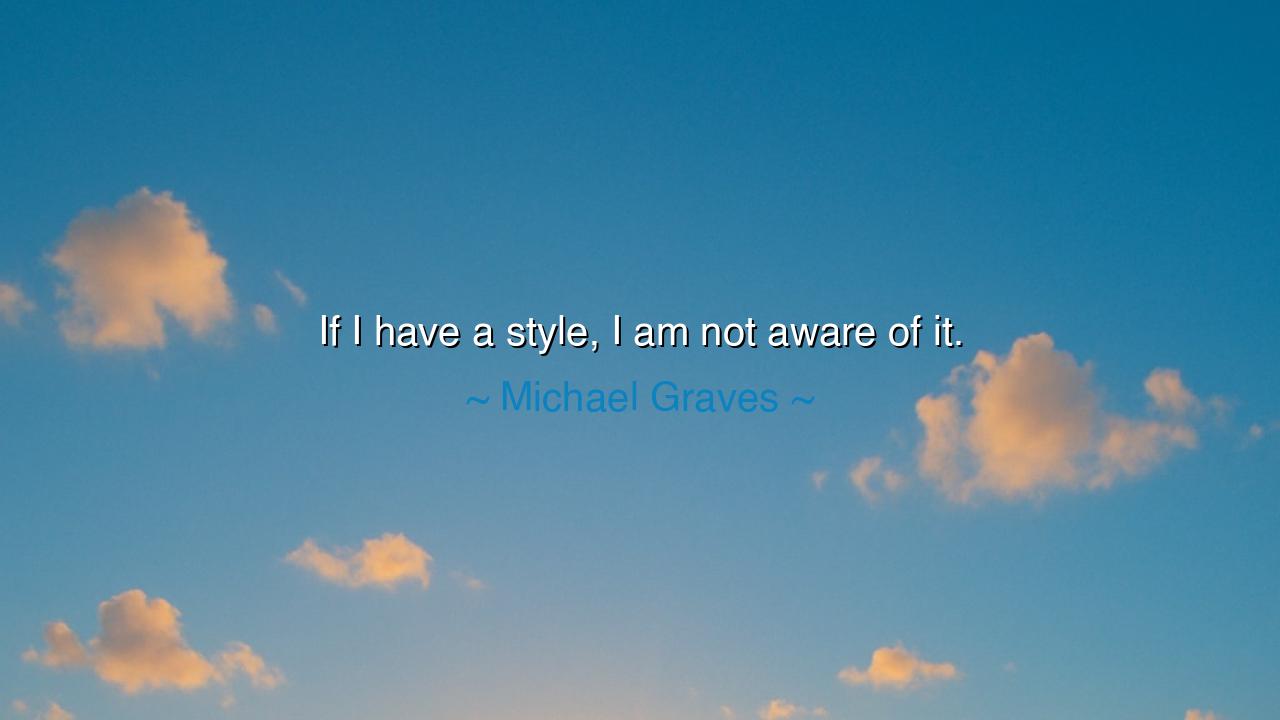
If I have a style, I am not aware of it.






"If I have a style, I am not aware of it." – Michael Graves
So spoke Michael Graves, the architect whose buildings sang with both reason and warmth, whose designs bridged the gap between function and feeling, between modern precision and ancient humanity. When he said, “If I have a style, I am not aware of it,” he was not practicing false humility, but revealing a profound truth about the nature of authentic creation. For the greatest artists do not chase style; they chase truth. To Graves, the act of creation was not about crafting a signature, but about serving purpose — to give beauty to life and life to beauty, until the boundary between self and work disappeared.
The origin of this quote lies in the heart of Graves’s philosophy. He rose to prominence in an age of stark modernism, when architecture had become an austere language of glass, steel, and silence. Yet Graves dared to infuse it once again with color, humor, and soul. His buildings, from the Portland Building in Oregon to the playful Teapot for Alessi, carried a warmth that defied the cold uniformity of his time. Critics labeled his approach Postmodern, and they called it his “style.” But Graves resisted the label. He understood that when art becomes self-conscious of its manner, it risks losing its innocence, its living pulse. A true creator does not design to impress; he designs to express something necessary and human.
To say “I am not aware of it” is to speak as a master who has transcended self-awareness. In every craft, there comes a point where technique and instinct become one — where the hands move not by calculation, but by communion with the work itself. The sculptor no longer thinks of chisels, the poet no longer counts syllables, and the architect no longer drafts with ego. In this sacred state, the artist disappears into the act of creation. What remains is not a style, but a soul made visible through form. Graves had reached this place, and his words reveal that his art was not built from formulas, but from a living conversation between the human heart and the built world.
Consider, for instance, the story of the Portland Building, completed in 1982. At a time when corporate towers rose like glass obelisks — proud, sterile, and identical — Graves imagined a structure that smiled. He painted it in warm earth tones, adorned it with whimsical forms, and gave it rhythm and character. Critics were divided: some mocked it, others praised it as revolutionary. But Graves was unmoved by the noise. For him, it was not about standing out; it was about bringing joy and meaning back into architecture. The building, like the man, was unconcerned with “style.” It simply existed, full of humanity, unapologetically alive.
In his words, one can hear the echo of the ancient sages — those who taught that mastery lies in effortless action. The Taoist calls it wu wei: to act without striving. The artist who truly knows his craft ceases to force it; he allows it to flow through him. So it was with Graves. His architecture did not scream to be seen; it breathed to be felt. His “style” was no more deliberate than the pattern of waves upon the shore — a natural unfolding of his spirit, shaped by years of devotion, humility, and listening.
But there is also wisdom here for every seeker, not only for the artist. In a world obsessed with labels — with personal brands, identities, and signatures — Graves reminds us that the highest form of self-expression is self-forgetfulness. To lose oneself in one’s work is not to vanish, but to merge with something greater. The potter, the teacher, the healer, the thinker — all find truth not by seeking recognition, but by serving their purpose fully, until the boundary between “style” and “being” dissolves.
So remember this teaching, my child of creation: do not strive for style, strive for sincerity. Let your craft grow from love, not from the desire to be admired. If your work carries your essence, it will bear your mark without your knowing. The flower does not paint its petals, and yet it is beautiful; the river does not sculpt its flow, and yet it is graceful. So too must you create — freely, earnestly, and without pretense. For when you cease to be aware of your style, you will have finally found your voice. And that voice, humble yet eternal, will sing through your work long after your name is forgotten.






AAdministratorAdministrator
Welcome, honored guests. Please leave a comment, we will respond soon